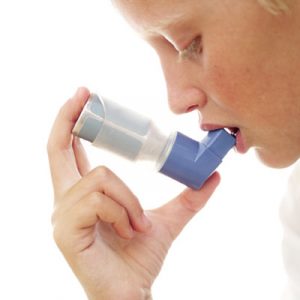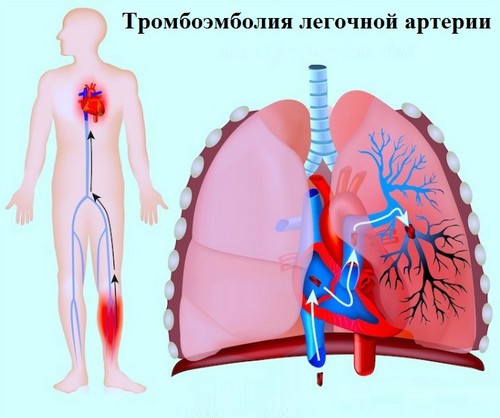Pulmonary heart disease, in which there is increase in the size of the right heart (atrium and ventricle) due to high pressure in the pulmonary circulation. In turn, hypertension in the small circle develops as a consequence of the defeat of the bronchi, the lungs, the pulmonary vessels and change the shape of the chest.
The causes of the different forms of pulmonary heart disease
Patients with diseases of the cardiovascular and respiratory systems should remember that the chances of occurrence of pulmonary heart disease is very high due to the fact that it causes a variety of diseases and conditions.
In many cases, the occurrence of pulmonary heart disease – the result of a state of neglect due to misdiagnosis or wrong treatment tactics. This is the end result leads to an overload of the right half of the heart and the occurrence of pulmonary heart disease.
The disease is:
- acute with severe;
- acute subacute course (process calms down, condition – between acute and chronic);
- chronic.
Each of the forms can occur as a result of many reasons, they can be divided into three large groups:
- diseases of the cardiovascular system;
- diseases of the respiratory system;
- changes in the chest (thoraco-diaphragmatic).

Cardiovascular causes of acute pulmonary heart disease with a severe course:
- massive pulmonary embolism;
- gas embolism of the arteries (blockage of the gas content);
- fat embolism of the arteries (the cessation of blood flow due to massive accumulations of fat particles);
- tumor embolism of the arteries (blockage of the conglomerates of tumor cells penetrated into the blood stream);
- parasitic embolism of the arteries (obstruction by accumulation of parasite eggs);
- thrombosis of the pulmonary artery (as opposed to thromboembolism because the blood clot is formed in any portion of the vessel and clog it at the time, as embolism is a blockage of the particles in the blood);
- thrombosis of the pulmonary veins.
Changes of broncho-pulmonary system, can lead to the development of acute pulmonary heart disease with severe is:
- heavy attack of a bronchial asthma until asthma status;
- massive pneumonia;
- pneumothorax (presence of air in the pleural cavity, in which negative pressure);
- show pneumomediastinum (massive accumulation of air in the mediastinum – the area of the chest between the two lungs).
Often acute pulmonary heart with severe develops due to embolism (blockage by a blood clot) pulmonary embolism (PE).

In turn, the pulmonary embolism causing pulmonary heart disease, occurs when:
- atrial fibrillation (often chaotic contractions of the Atria);
- hypertension;
- pathological changes in the vessels of the lesser circulation – primarily, increased blood pressure, stagnation and microcirculatory disorders;
- pathological changes in the clotting abilities of the blood – clotting and increase the inhibition of the anticoagulation system;
- ischemic heart disease (oxygen starvation of the myocardium);
- heart defects that have arisen due to the development of rheumatism;
- the venous thrombosis (inflammatory changes in the wall of the vein with a thrombotic deposits);
- vascular pathologies in the system of the pulmonary artery – systemic atherosclerosis (deposition of fatty plaques on the inner wall of blood vessels) and vasculitis (inflammation of vessel walls and their subsequent destruction);
- chronic inactivity (in particular, if necessary, prolonged bed rest after injury, surgery, coma, etc.);
- surgical procedures on the veins of the lower extremities and pelvis.
Formed a kind of vicious circle: the pulmonary artery suffers from cardiovascular disease, which in turn leads to pulmonary heart. In the last 8-10 years clinicians have noted the frequent occurrence of pulmonary heart disease-related increase in the incidence of the pulmonary embolism.
Cardiovascular causes of acute pulmonary heart disease with a subacute course:
- embolism of one or more branches of the pulmonary artery (not the main trunk);
- thrombosis of these branches, characterized by frequent relapses;
- arteriai system of the pulmonary artery (the inflammatory process in the vascular wall of various origins – most often bacterial).

Changes of broncho-pulmonary system, can lead to the development of acute pulmonary heart disease with a subacute course, this:
- pulmonary infarction (necrosis of one of its sections);
- valve (or valve) pneumothorax (a condition in which air enters the pleural cavity, but to go back can’t because of obstacles in the form of the valve, formed by the nearby governments).
- acute inflammation of the lung that has engulfed most of the lung tissue;
- a severe form of bronchial asthma (including status asthmaticus);
- limfangoit cancer of the lung (inflammation of the lymph vessels of the lung due to the mass accumulation in them of cancer cells, brought with the lymph flow).
Changes in the chest that can cause acute pulmonary heart subacute course is chronic hypoventilation (decrease ventilation of the lung), which may arise under such pathological conditions, such as:
- botulism (toxicoinfections damage to the nervous system occurring after ingestion of food contaminated with the causative agents of botulism);
- polio (damage to the spinal cord poliovirus);
- myasthenia gravis (an autoimmune muscular involvement with their characteristic fatigue).
Cardiovascular causes of development of chronic pulmonary heart disease:
- the primary increase in arterial pressure in the artery;
- thromboembolism of branches of pulmonary artery;
- arteriitis;
- vasculitis – inflammation of the vascular wall with its destruction, in particular, allergic, occlusive (blockage), nodular, lupus origin;
- atherosclerotic changes in the walls of the pulmonary artery;
- reduction of the lumen of the pulmonary artery and pulmonary veins due to the pressure from the outside (aneurysmal expansion of the aorta, mediastinal tumors, etc.);
- re embolism;
- lung resection (removal of a segment of lung tissue).
Changes of broncho-pulmonary system, can lead to the development of chronic pulmonary heart:
- diseases accompanied by reduction of the lumen of bronchi (asthma, chronic obstructive bronchitis (as well as its form with asthmatic component), pulmonary fibrosis (germination connective tissue), pulmonary emphysema);
- pathology, in which the bronchi undergo a pressure from the outside (fibrosis, granulomatose).
Changes in the thorax, which limited her mobility, as a consequence, there is chronic pulmonary heart:
- kyphoscoliosis of the thoracic spine (curvature in the anterior-posterior and lateral projections);
- easy polycystic (multiple cysts due to underdevelopment of the lung);
- deformity of the chest;
- pleural synechia, fibrotic folds (connective jumper in the pleural cavity, which do not allow easy to deal fully);
- the so-called Pickwickian syndrome, triggered by obesity, the inability to do deep breaths and exhalations;
- paresis (partial paralysis) of the diaphragm;
- neuromuscular lesions in poliomyelitis;
- ankylosing spondylitis (chronic inflammation of the joints of the spine);
- violations of excursion of thorax after an unsuccessful thoracoplasty (surgical manipulation, leading to changes in shape of the chest).
In recent years, the clinic observed an increase in cases of chronic heart due to the increased frequency of obstructive diseases in the population.
The development of the disease
Acute pulmonary heart develops in the following way. Diseases of the pulmonary circulation lead to a narrowing of the pulmonary vessels on long haul and the emergence of persistent bronchospasm. Because of this, there comes a decrease in pressure in the systemic circulation, worsening pulmonary ventilation and gas exchange (carbon dioxide does not leave the lung tissue, and oxygen does not saturate it).
It is a vicious circle: because of these phenomena in the pulmonary circulation increases blood pressure, causing right heart (atrium and ventricle) suffer overload and gradually expanded due to stagnation of blood in them. In advanced cases due to the fact that the blood is in no hurry to leave the right parts of the heart, it presses on the surrounding tissue due to increased permeability of the pulmonary capillaries, the fluid gets easy access and goes into the alveoli – pulmonary edema occurs.
In the development of chronic pulmonary heart plays the role of increasing the pressure in small circle of blood circulation due to pathological changes in the lungs. In obstructive processes impaired patency of the bronchi, as a consequence, the lungs are ventilated (aired) uneven. Due to this impaired gas exchange – getting rid of carbon dioxide and oxygen saturation, patients naturally suffer from the fact that a disrupted supply of oxygen to tissues.

In acute and in chronic heart progression occurs disturbance of acid-base status of the tissues. First, they compensated for the expense of internal reserves of the organism, but quickly comes decompensation.
In acute severe or too prolonged chronic pulmonary heart in patients who tolerate the excessive load, over time, begin to develop degenerative changes (malnutrition), and then necrosis (necrosis), which can provoke myocardial infarction.
Symptoms
Acute pulmonary heart with severe develops most often for 4-5 hours (at least – 1-2 hours or several days). Its main symptoms:
- sharp deterioration of health on a background of physiological well-being;
- chest pain pressing nature, medium intensity;
- excited state (due to the abruptly onset of hypoxia);
- signs acute onset of heart failure.
Signs that come with acute heart failure are:
- sudden shortness of breath;
- abruptly onset of cyanosis of the skin and visible mucous membranes; especially pronounced acrocyanosis – cyanosis of the fingertips, nose, ears;
- swelling of the veins in the neck;
- enlargement and tenderness of the liver;
- inability to perform physical actions;
- possible swelling of the limbs.
If the cause of acute pulmonary heart disease is a thromboembolism of the main trunk of the pulmonary artery, all of these symptoms can develop from several minutes to half an hour. In this case, very quickly come:
- a state of shock because of the expressed disorders in the cardiovascular system;
- pulmonary edema.
If you do not take any action that will begin the development of necrosis (necrosis) of the lungs. Signs of a heart attack (necrosis) of the lungs during an acute heart heart:
- increase chest pain associated with the act of breathing, shortness of breath and cyanosis (cyanosis) of the skin and mucous membranes;
- the cough is mostly dry, but there may be a separation of a small amount of sputum;
- have about half of the patients – the appearance of hemoptysis;
- the increase in body temperature is associated with aseptic necrosis, which in this case manifests itself in the resistance (resistance) of hyperthermia the use of antibiotics;
- the weakening of breathing.
Acute pulmonary heart with sub-acute course is manifested by acute symptoms, but more moderate in comparison with the acute course. It is such features as:
- average intensity of pain in the chest when breathing;
- shortness of breath, which may pass quickly enough;
- increased heart rate and palpitations;
- fainting.
Chronic pulmonary heart can be:
- compensated;
- decompensated.
Depend on clinical symptoms and pathology.
In the compensation stage, there are signs of the underlying pathology that triggered the emergence of chronic pulmonary heart disease – the symptoms of enlargement of the right half of the heart begin to develop gradually, in the later stages.
It is such features as:
- shortness of breath, worse in some States – during physical activity, in the supine position, when breathing cold air. Shortness of breath in this case is twofold in origin – occurs through the respiratory and heart failure;
- pain in the heart area – they appear due to the fact that his right half because of the overload doing more than usual work, and the power remains the same. Painful sensations can also arise from the fact that the stretched pulmonary artery;
- blueness of the skin and visible mucous membranes;
- hypertension;
- the decreased body temperature.
Noteworthy is the fact that all of these symptoms are manifested more intensely, if there are inflammatory processes in the lungs. A characteristic feature – even in severe pneumonia patients with pulmonary heart body temperature becomes normal, or at least reaches 37 degrees Celsius.
Some patients can join signs of a stomach ulcer, which arises because of the violation of gas composition of blood.
If there comes a stage of decompensation, observed the following clinical picture:
- the thrust buildup of the swelling;
- progressive enlargement and tenderness of the liver;
- the deterioration of the produce urine;
- violations of the Central nervous system – headache, attacks of dizziness, tinnitus, drowsiness, apathy. Such signs appear due to the fact that the structures of the Central nervous system loses the oxygen in the required amount and be subject to the influence of oxidized products.
Diagnosis of pulmonary heart disease
The diagnosis of pulmonary heart disease put on the basis of the anamnesis of the disease, developing symptoms and data received from the application of additional methods of examination. In diagnosis the doctor also focuses on the presence of diseases that can trigger the development of pulmonary heart.

Additional instrumental and laboratory research methods, which are used in the diagnosis of pulmonary heart disease:
- roentgenography of organs of a thorax – in the picture in chronic, advanced cases the right heart is enlarged and pulmonary artery bulges. Radiography informative in the later stages of the disease, as the thickening of the walls of the heart in the initial stages is not significant to be manifest on x-ray picture;
- Ultrasound of the heart – it determines the thickening of the right heart;
- electrocardiography will reveal signs of ischemia of the right heart in some cases, a rhythm disturbance;
- pulmonary angiography is used to diagnose pulmonary embolism;
- spirometry – when it determined the degree of respiratory failure and use these signs to indirectly draw conclusions about the degree of development of pulmonary heart;
- coagulation and prothrombin index – determine the state of the blood coagulation system.
Treatment of pulmonary heart disease
Therapeutic measures in pulmonary heart in the first place should be aimed at treatment of underlying disease. Apply:
- the broad-spectrum antibiotics in massive pneumonia;
- antihypertensive drugs in arterial hypertension;
- cardiac glycosides cardiac;
- nonsteroidal anti-inflammatory agents vasculitis;
- oxygen therapy in chronic obstructive diseases (in some cases using night oxygen therapy)
and so on.
Shown symptomatic therapy depending on the evolving conditions and symptoms:
- with increased viscosity of blood – anticoagulants to prevent blood clots. In some cases, as an alternative use an old but effective method is phlebotomy (practiced in the case that the ratio of erythrocytes to plasma is higher than normal);
- to facilitate the removal of sputum from the respiratory system – mucolytic (mucus-thinning) drugs
and so on.
You should consider the fact that the development of heart failure in patients with pulmonary heart – a bad prognostic sign, which can lead to death.
Therefore, the development of signs of heart failure requires immediate intensive care:
- diuretics (due to their diuretic effect will decrease the load on the heart);
- nitrates (used to improve blood flow in the right heart, which suffers from the increased load on them);
- phosphodiesterase inhibitors (used in obstruction of the bronchi);
- the inotropes are (they are used in the deterioration of cardiac contractility).
In acute pulmonary heart with the acute course and its chronic advanced form may develop shock, which leads to clinical death due to cardiac arrest.
In this case, carried out resuscitation:
- indirect heart massage;
- intubation of the airway with mechanical ventilation.
If the condition was caused by thromboembolism of the pulmonary artery, surgery is needed urgently, during which the pulmonary artery is removed a blood clot and is administered thrombolytic preparations.
If the patient has a chronic pulmonary heart, and conservative therapy is ineffective, then it is necessary surgery – heart transplant (often in combination with transplantation of lungs). This surgery is performed very rarely because of a lack of donors (e.g. in North America is 10-15 per year), but it is a chance to continue the patient’s life. After heart and lung transplantation life expectancy is about half of the operated is 5 years.
Prevention
Preventing the occurrence of pulmonary heart disease is the prevention and treatment of diseases that cause it. Particular caution should be exercised in relation to pulmonary embolism.

Emphysema and obstructive diseases of respiratory organs at advanced stages always lead to the development of pulmonary heart.
Pulmonary heart: how to live with it?
The prognosis of acute pulmonary heart disease with acute and for the chronic form at the stage of decompensation difficult, more favorable in the acute form subacute chronic over and under compensation.
Forecast and current depend on:
- the severity of the disease;
- the degree of pulmonary hypertension.
According to various estimates from 10 to 50% of patients with this pathology are over 5 years (this figure increases with the regular inhalation of oxygen).
Even with early diagnosis and appropriately tailored therapy complete cure does not occurbecause pulmonary heart is in fact the result of emergency conditions (pulmonary embolism) or the prolonged course of many chronic diseases.
Mortality about pulmonary heart disease remains high. Annually in the world due to pulmonary heart disease kills about 20 thousand people, about 300 thousand hospitalitynet to the hospital about this disease.



